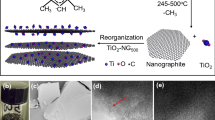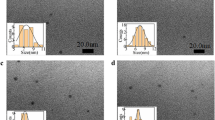Abstract
In this study, the graphene oxide (GO)-TiO2 nanocomposite film prepared by the sol–gel method was used to optimize the photoelectric performance of the perovskite solar cells (PSCs), which structure is based on the carbon electrode and no hole transport layer. Through a series of scientific experiments, it has been proved that the GO–TiO2 nanocomposite film has excellent electrical properties. The electron transport layer which containing 1 wt% of GO makes the PSCs have the most excellent performance. Compared with the controlling PSCs, the photoelectric conversion efficiency of PSCs, which containing 1 wt% GO, increased by 9.3%, from 12.44 to 13.60%. Short-circuit current density (Jsc) increased by 5.99%, from 21.55 to 22.84 mA/cm2, and open circuit voltage remained basically unchanged. It can be seen from the measurement results that the trend of incident photon-to-electron conversion efficiency spectrum is consistent with J–V characteristics, indicating that the PSCs device containing 1 wt% GO has the best electron extraction and transfer performance. However, when too much GO is used, the increased surface charge trap state will lead to the acceleration of carrier recombination and the decrease of electron transport path, and the photovoltaic parameters show a downward trend.










Similar content being viewed by others
References
N.K. Kumawat et al., Structural, optical, and electronic properties of wide bandgap perovskites: experimental and theoretical investigations. Phys. Chem. A. 120(22), 3917–3923 (2016). https://doi.org/10.1021/acs.jpca.6b04138
P. Gao, M. Gratzel, M.K. Nazeeruddin, Organohalide lead perovskites for photovoltaic applications. Energy Environ. Sci. 7(8), 2448–2463 (2014)
S.D. Stranks et al., Electron-hole diffusion lengths exceeding 1 micrometer in an organometal trihalide perovskite absorber. Science 342(6156), 341–344 (2013). https://doi.org/10.1126/science.1243982
A. Kojima et al., Organometal halide perovskites as visible-light sensitizers for photovoltaic cells. J. Am. Chem. Soc. 131(17), 6050–6051 (2009). https://doi.org/10.1021/ja809598r
H.J. Snaith, Perovskites: the emergence of a new era for low-cost, high-efficiency solar cells. J. Phys. Chem. Lett. 4(21), 3623–3630 (2013). https://doi.org/10.1021/jz4020162
W. Nie et al., High-efficiency solution-processed perovskite solar cells with millimeter-scale grains. Science 347(6221), 522–525 (2015). https://doi.org/10.1126/science.aaa0472
A. Yella, M. Gratzel, Porphyrin-sensitized solar cells with cobalt (II/III)-based redox electrolyte exceed 12 percent efficiency. Science 334(6056), 629–634 (2011). https://doi.org/10.1126/science.1209688
J. Burschka et al., Sequential deposition as a route to high-performance perovskite-sensitized solar cells. Nature 499(7458), 316–319 (2013). https://doi.org/10.1038/nature12340
K. Chen et al., Low-dimensional perovskite interlayer for highly efficient lead-free formamidinium tin iodide perovskite solar cells. Nano Energy 49, 411–418 (2018)
Y.G. Tu et al., Diboron-assisted interfacial defect control strategy for highly efficient planar perovskite solar cells. Adv. Mater. 30(49), 1805085 (2018)
D.Y. Luo et al., Enhanced photovoltage for inverted planar heterojunction perovskite solar cells. Science 360(6396), 1442–1446 (2018). https://doi.org/10.1126/science.aap9282
T.H. Liu et al., Stable formamidinium-based perovskite solar cells via in situ grain encapsulation. Adv. Energy Mater. 8(22), 1800232 (2018). https://doi.org/10.1002/aenm.201800232
X.Y. Zhu et al., Improved photovoltaic properties of nominal composition CH3NH3Pb0.99Zn0.01I3 carbon-based perovskite solar cells. Opt. Express 26(26), A984 (2018). https://doi.org/10.1364/OE.26.00A984
P. Tonui et al., Perovskites photovoltaic solar cells: an overview of current status. Renew. Sust. Energy Rev. 91, 1025–1044 (2018). https://doi.org/10.1016/j.rser.2018.04.069
L. Qiu, L.K. Ono, Y. Qi, Advances and challenges to the commercialization of organic-inorganic halide perovskite solar cell technology. Mater Today Eenrgy 7, 169–189 (2018). https://doi.org/10.1016/j.mtener.2017.09.008
L. Etgar et al., Mesoscopic CH3NH3PbI3/TiO2 heterojunction solar cells. J. Am. Chem. Soc. 134(42), 17396 (2012). https://doi.org/10.1021/ja307789s
Z. Zhu et al., Efficiency enhancement of perovskite solar cells through fast electron extraction: the role of graphene quantum dots. J. Am. Chem. Soc. 136(10), 3760–3763 (2014). https://doi.org/10.1021/ja4132246
G.K. Ramesha, S. Sampath, Electrochemical reduction of oriented graphene oxide films: an in situ raman spectroelectrochemical study. J. Phys. Chem. C 113(19), 7985–7989 (2009). https://doi.org/10.1021/jp811377n
K. Kumar et al., Synthesis and characterizations of exohedral functionalized graphene oxide with iron nanoparticles for humidity detection. J. Mater. Sci.: Mater. Electron. 30(14), 13013–13023 (2019). https://doi.org/10.1007/s10854-019-01663-9
U. Kumar et al., Carbon nanotube: synthesis and application in solar cell. J. Inorg. Organomet. Polym. 26(6), 1231–1242 (2016). https://doi.org/10.1007/s10904-016-0401-z
C.N.R. Rao et al., Some novel attributes of graphene. J. Phys. Chem. Lett. 1(2), 572–580 (2010). https://doi.org/10.1021/jz9004174
G. Williams, P.V. Kamat, Graphene-semiconductor nanocomposites. Excited state interactions between ZnO nanoparticles and graphene oxide. Langmuir 25(24), 13869–13873 (2009). https://doi.org/10.1021/la900905h
X. Yin et al., Highly efficient inverted perovskite solar cells based on self-assembled graphene derivatives. J. Mater. Chem. A. 6(42), 20702–20711 (2018). https://doi.org/10.1039/C8TA05955A
K. Domanski et al., Systematic investigation of the impact of operation conditions on the degradation behaviour of perovskite solar cells. Nat. Energy 3(1), 61–62 (2018). https://doi.org/10.1038/s41560-017-0060-5
N. Zibouche, G. Volonakis, F. Giustino, Graphene oxide/perovskite interfaces for photovoltaics. J. Phys. Chem. C 122(29), 16715–16726 (2018). https://doi.org/10.1021/acs.jpcc.8b03230
S. Das et al., The role of graphene and other 2D materials in solar photovoltaics. Adv. Mater. 31(1), 1802722 (2019). https://doi.org/10.1002/adma.201802722
S. Feng et al., High-performance perovskite solar cells engineered by an ammonia modified graphene oxide interfacial layer. ACS Appl. Mater. Interfaces. 8(23), 14503–14512 (2016). https://doi.org/10.1021/acsami.6b02064
D. Xiong et al., Controllable oxygenic functional groups of metal-free cathodes for high performance lithium ion batteries. J. Mater. Chem. A. 3(21), 11376–11386 (2015). https://doi.org/10.1039/C5TA01574J
A. Fakharuddin et al., Role of morphology and crystallinity of nanorod and planar electron transport layers on the performance and long term durability of perovskite solar cells. J. Power Sources 283, 61–67 (2015). https://doi.org/10.1016/j.jpowsour.2015.02.084
X. Xu et al., Highly efficient planar perovskite solar cells with a TiO2/ZnO electron transport bilayer. J. Mater. Chem. A. 3(38), 19288–19293 (2015). https://doi.org/10.1039/C5TA04239A
M.A. Mahmud et al., Low temperature processed ZnO thin film as electron transport layer for efficient perovskite solar cells. Solar Energy Mater. Solar Cells 159, 251–264 (2017). https://doi.org/10.1016/j.solmat.2016.09.014
Z.G. Xu, H.Y. Gao, G.X. Hu, Solution-based synthesis and characterization of a silver nanoparticle–graphene hybrid film. Carbon 49(14), 4731–4738 (2011). https://doi.org/10.1016/j.carbon.2011.06.078
K. Jasuja, V. Berry, Implantation and growth of dendritic gold nanostructures on graphene derivatives: electrical property tailoring and raman enhancement. ACS Nano 3(8), 2358–2366 (2009). https://doi.org/10.1021/nn900504v
N.J. Jeon et al., Solvent engineering for high-performance inorganic-organic hybrid perovskite solar cells. Nat. Mater. 13(9), 897–903 (2014)
N. Ahn et al., Highly reproducible perovskite solar cells with average efficiency of 18.3% and best efficiency of 19.7% fabricated via Lewis base adduct of lead(II) iodide. J. Am. Chem. Soc. 137(27), 8696–8699 (2015). https://doi.org/10.1021/jacs.5b04930
M. Liu, M.B. Johnston, H.J. Snaith, Efficient planar heterojunction perovskite solar cells by vapour deposition. Nature 501(7467), 395–398 (2013). https://doi.org/10.1038/nature12509
Q. Chen et al., Planar heterojunction perovskite solar cells via vapor-assisted solution process. J. Am. Chem. Soc. 136(2), 622–625 (2013). https://doi.org/10.1021/ja411509g
A.T. Barrows et al., Efficient planar heterojunction mixed-halide perovskite solar cells deposited via spray-deposition. Energy Environ. Sci. 7(9), 2944–2950 (2014). https://doi.org/10.1039/C4EE01546K
B. Xin et al., Effects of simultaneously doped and deposited Ag on the photocatalytic activity and surface states of TiO2. J. Phys. Chem. B 109(7), 2805–2809 (2005). https://doi.org/10.1021/jp0469618
M.K. Gangishetty et al., Plasmonic enhancement of dye sensitized solar cells in the red-to-near-infrared region using triangular core–shell Ag@SiO2 nanoparticles. ACS Appl. Mater. Interfaces. 5(21), 11044–11051 (2013). https://doi.org/10.1021/am403280r
W.S. Yang et al., Iodide management in formamidinium-lead-halide-based perovskite layers for efficient solar cells. Science 356(6345), 1376–1379 (2017). https://doi.org/10.1126/science.aan2301
M.M. Tavakoli et al., High efficiency and stable perovskite solar cell using ZnO/RGO QDs as an electron transfer layer. Adv. Mater. Interfaces 3(11), 1500790 (2016). https://doi.org/10.1002/admi.201500790
M. Ye et al., Metal/graphene oxide batteries. Carbon 125, 299–307 (2017). https://doi.org/10.1016/j.carbon.2017.09.070
H. Chen, C. Li, L. Qu, Solution electrochemical approach to functionalized graphene: history, progress and challenges. Carbon 140, 41–56 (2018)
Acknowledgements
This research was funded by the National Natural Science Foundation of China (NSFC) (11974266,11704293), the Fundamental Research Funds for the Central Universities under Grant WUT (2018IB017).
Author information
Authors and Affiliations
Corresponding author
Ethics declarations
Conflicts of interest
The authors declare no conflict of interest.
Additional information
Publisher's Note
Springer Nature remains neutral with regard to jurisdictional claims in published maps and institutional affiliations.
Rights and permissions
About this article
Cite this article
Yang, H., Liu, N., Ran, M. et al. Enhancing electron transport in perovskite solar cells by incorporating GO to the meso-structured TiO2 layer. J Mater Sci: Mater Electron 31, 3603–3612 (2020). https://doi.org/10.1007/s10854-020-02913-x
Received:
Accepted:
Published:
Issue Date:
DOI: https://doi.org/10.1007/s10854-020-02913-x




